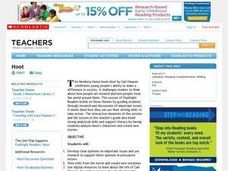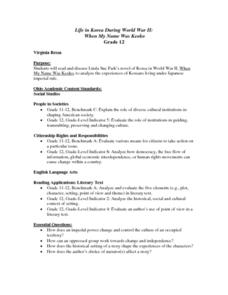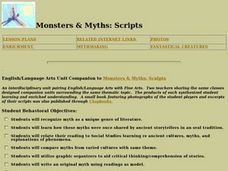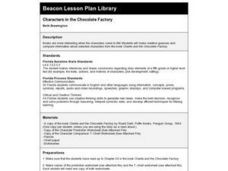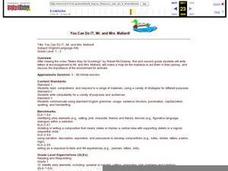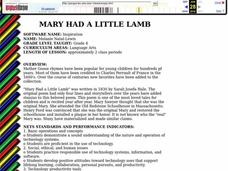Curated OER
Titanic
Students conduct research with the purpose of writing a report about the Titanic. They use a variety of resources. The students produce a written document that has plenty of documented information. They also compare the information that...
Curated OER
Pic-A-Fic: Choosing Fiction for Every Taste
Sixth graders examine and categorize a selection of title representing fiction genres. In this fiction genres instructional activity, 6th graders analyze and identify a variety of titles in the fiction genre. Students then find these...
Curated OER
Creating Transitions
Fourth graders analyze the use of transitions in text. In this transitions lesson plan, 4th graders determine how and why a transition is used at a specific time in a piece of writing. They show transitions by using movements before...
Curated OER
Examining Persuasive Literature
Examine persuasive literature and writing. In this persuasive literature lesson, pupils work through a variety of activities over the course of three weeks (each week is planned by day). The unit's purpose is to examine examples of...
Curated OER
Magical Creatures Land
The opening of J.R.R. Tolkein’s The Hobbit provides a model of how to use rich details to create a setting. After reading the description of Bilbo Baggins’ abode, young writers create their own magical home for a fantasy creature. The...
Curated OER
A Fairy Tale: Italian Folklore
Young scholars work in groups to write an original fairy tale in Italian. They research the components of a fairy tale, compare and contrast fairy tales with myths and follow an outline to write a complete, 15-20 page fairy tale.
Curated OER
Comparing Two Poe Classics
Students read and discuss The Black Cat and The Tell-Tale Heart. In this poetry lesson, students construct a Venn diagram to compare and contrast two pieces of literature.
Curated OER
Ending a Famous Fairy Tale
Altering the ending of a famous fairy tale is a really fun way for kids to experience creative writing. The instructional activity here has them do just that! Learners listen to the famous fairy tale, "The Twelve Brothers," and change...
Curated OER
Censorship In Fahrenheit 451
Tenth graders explore the concept of censorship through a reading of Fahrenheit 451. They discuss the issue and its relation to contemporary society. Students work in groups to debate the pros and cons of censorship in our society.
Curated OER
So Foul and Fair a Play
Students watch various interpretations of Shakespeare's Macbeth in film. In groups, they examine the setting, characters, music and sequence. They compare and contrast the various films and discuss the differences. They write an essay on...
Curated OER
Book Illustration
Students view a video and discuss what illustrations in a book show and don't show. In this observation lesson plan, students look at the details on a page in Alice in Wonderland and create an illustration.
Curated OER
Romeo & Juliet (Drama)
Ninth graders read and internalize the drama Romeo and Juliet by William Shakespeare. Many intriguing and thought provoking assignments are waiting for the completion of students within this lesson profile.
Curated OER
Of Mice and Men: Viewing Guide
In this Of Mice and Men viewing guide worksheet, students study movie terminology as they read brief descriptions and respond to 26 short answer questions as the watch the film based on Steinbeck's novel.
Curated OER
"Hoot" by Carl Hiaasen
Students complete a variety of activities that revolve around the book "Hoot" by Carl Hiaasen. They view and discuss stills from the move "Hoot" and compose original storylines, conduct Internet research about the life of Carl Hiaasen,...
Curated OER
LA CENERENTOLA (Cinderella)
Young scholars investigate different cultures' versions of the Cinderella tale in comparison to the Rossini opera synopsis. They experience dramatizing a Cinderella tale and study about the group and individual process required for...
Curated OER
Life in Korea During World War II: When My Name Was Keoko
Twelfth graders review facts about roles of Asia and Japan in World War II, read When My Name Was Keoko to familiarize themselves with daily life and historic events during World War II in Korea, and participate in student-led...
Curated OER
Because of Winn-Dixie
Students complete a variety of activities related to the book "Because of Winn-Dixie" by Kate DiCamillo. They create a scrapbook of the characters in the book, play a reading comprehension maze game, and participate in an online...
Curated OER
Monster and Myths: Scripts
Students explore characteristics of the myth genre. In this myth lesson, students become familiar with various myths and the cultures they were derived from. Students compare in a graphic organizer. Students write...
Curated OER
Panther Exam: Writing a Play
Students demonstrate their knowledge of panthers by writing a play on the subject. In this animal life lesson, students view a slide-show on school computers of a veterinary exam of a panther. Students utilize this...
Curated OER
Heaven or Ground Hog Day?
Students discover the ideas of enlightenment by reading historical poetry. In this philosophical lesson, students read poems by Sir Walter Scott and Sergeant Joyce Kilmer while discussing the themes of the writing with classmates....
Curated OER
A New Look at Romeo and Juliet
Students explore life and language development in the Elizabethan Age. In this English instructional activity students complete web-quests and other activities surrounding Shakespeare's Romeo and Juliet.
Curated OER
Characters in the Chocolate Factory
Pupils dress and act as selected characters from Roald Dahl's "Charlie and the Chocolate Factory". They identify each other and make predictions about the upcoming chapters based on their observations about the characters.
Curated OER
You Can Do It, Mr. And Mrs. Mallard!
Students watch the video "Make Way for Ducklings" by Robert Mc Closkey. They write letters to Mr. and Mrs. Mallard and make a map for the mallards. They talk about the importance of animal habitats.
Curated OER
Mary Had A Little Lamb
Fourth graders listen and observe the role play of the various versions of the poem. They take notes while listening and observing and develop their own versions of "Mary Had a Little Lamb".













